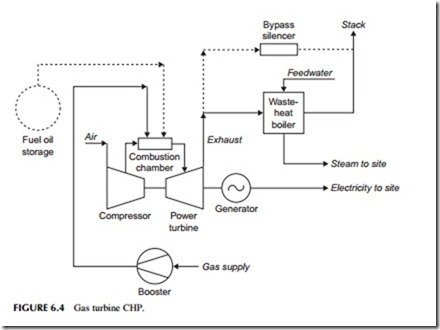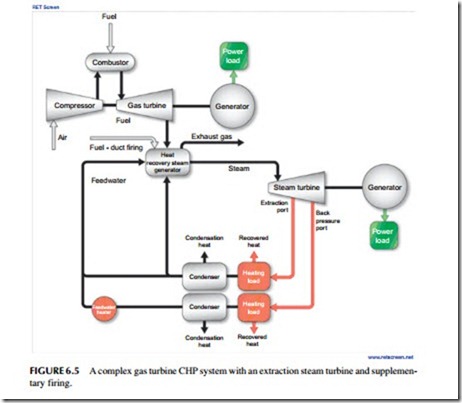GAS TURBINES
Unlike steam turbines, gas turbines burn fuel directly. Large industrial gas turbines operate with energy conversion efficiencies up to 42%, while smaller aero-derivative gas turbines can operate with an efficiency up to 46%. Gas turbine–generating capacities typically range from 1 MW up to nearly 400 MW. Units of any size can be used in CHP systems and gas turbines are probably the cheapest prime movers available today. The output of a gas turbine CHP plant can be modulated to suit the demand for heat and electricity, but they are probably best suited to continuous operation at or near full output if they are to achieve the best efficiency.
Gas turbines can burn a variety of fuels, including natural gas, distillate fuels, and biogas. However, the most popular fuel is natural gas. A stationary gas turbine is designed to generate electrical power, so there must be a market for the power generated by the plant if it is to be economically viable as part of a CHP plant. The heat output from the engine is all found it its exhaust gases, and it is these that must be exploited to provide steam or hot water. This will normally be achieved by fitting the unit with a heat-recovery steam generator. The energy contained in the exhaust of a gas turbine is suitable for generating high- pressure steam suitable for many industrial applications.
There are three main configurations for a gas turbine CHP plant. The sim- plest is to install a gas turbine to generate electrical power and use the exhaust gases to generate steam, all of which is used for process heat or to meet other heat demands (Figure 6.4). This basic configuration can be made more flexible in one of two ways. The first is to fit the plant with a steam turbine too, so that any excess steam can be used to generate further electrical power as in a com- bined cycle plant. The second is to fit the boiler with a supplementary firing system so that it can generate additional steam beyond the quantity that the gas turbine can provide.4 There can also be a combination of supplementary firing and a steam turbine to provide more flexibility and the steam turbine
may be a condensing steam turbine, back-pressure steam turbine, or extraction steam turbine (Figure 6.5).
Which of these configurations is chosen will depend on the balance of demand for heat and electrical power. If heat demand is relatively constant, then the simplest configuration can be chosen with the size set to produce all the heat required. Electrical output can then be supplemented if necessary from the grid. If electrical demand is high, or if power is to be exported to the grid, then one of the other configurations might make more economic sense. If the system is designed to closely match electrical and heat demand, efficiencies up to 90% can be achieved.
Gas turbine CHP systems will generally be installed in industrial situations where heat demand is high. The principal emission that needs to be controlled is nitrogen oxide. It may be possible to meet regulatory requirements without additional emission control systems when the gas turbine is small, but larger units will generally require some exhaust gas treatment system. Very large units may also need systems to control the emissions of carbon monoxide and hydrocarbons.

